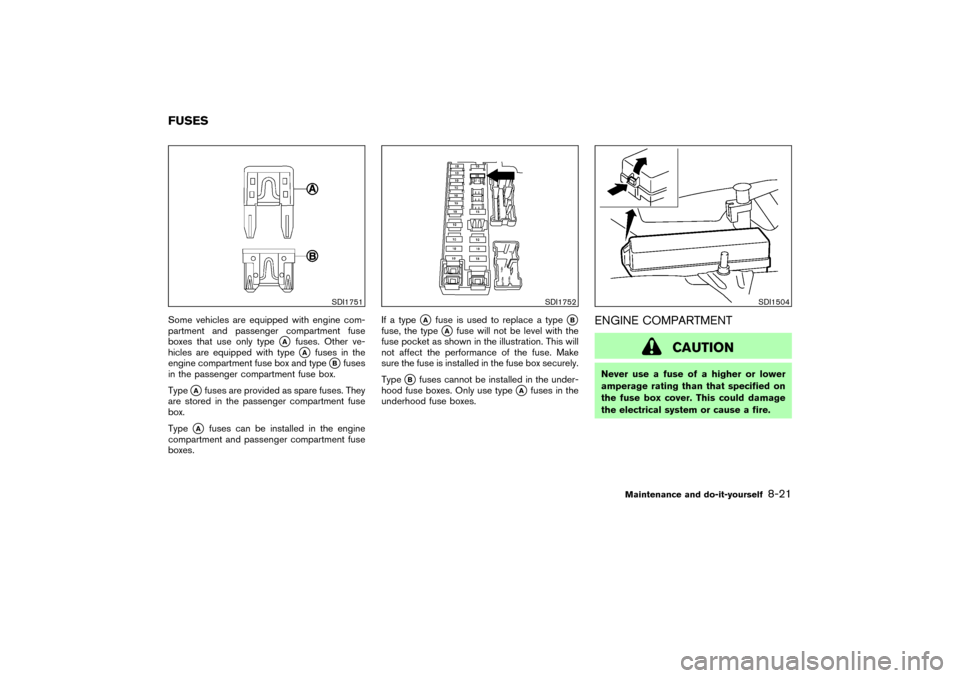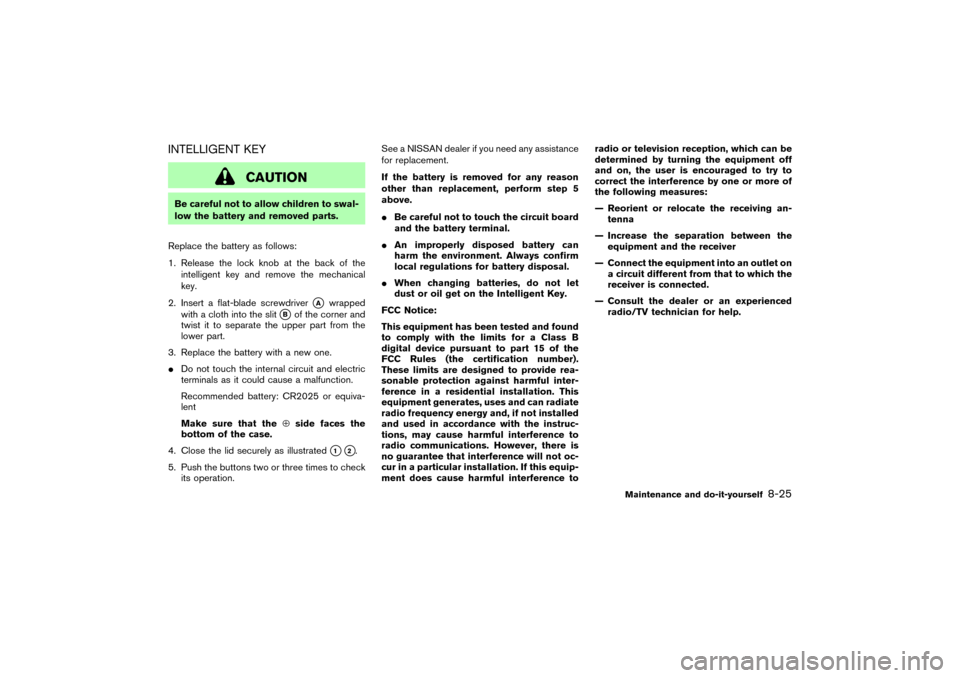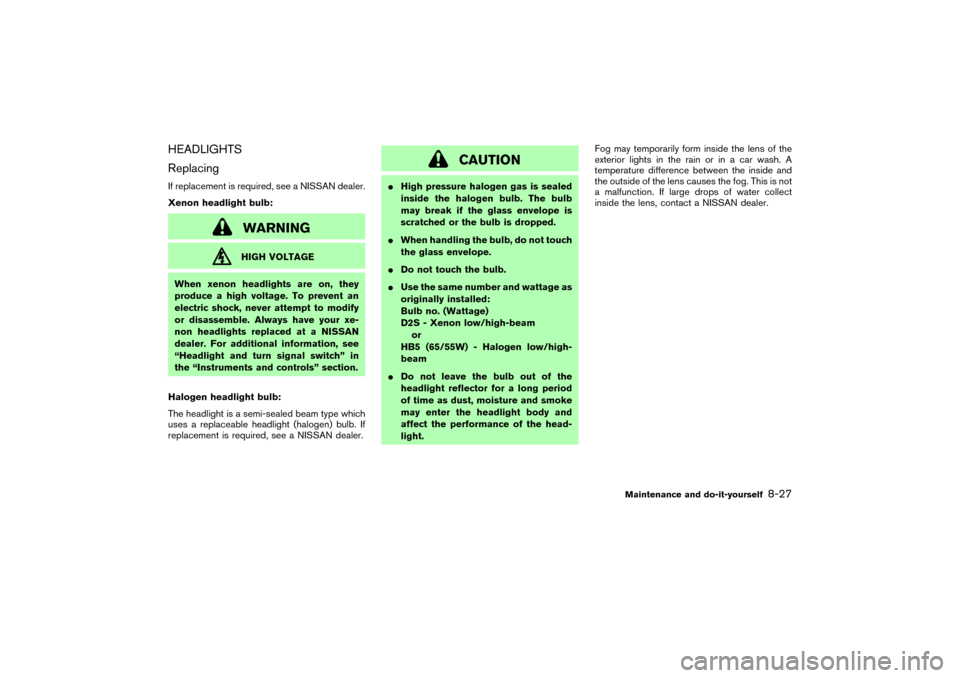Page 285 of 345

Contact a NISSAN dealer if checking or replace-
ment is required.
SELF-ADJUSTING BRAKESYour vehicle is equipped with self-adjusting
brakes.
The disc-type brakes self-adjust every time the
brake pedal is applied.
WARNING
See a NISSAN dealer and have it
checked if the brake pedal height does
not return to normal.BRAKE PAD WEAR INDICATORSThe disc brake pads on your vehicle have au-
dible wear indicators. When a brake pad re-
quires replacement, it will make a high pitched
scraping or screeching sound when the vehicle
is in motion whether or not the brake pedal is
depressed. Have the brakes checked as soon as
possible if the wear indicator sound is heard.
Under some driving or climate conditions, occa-
sional brake squeak, squeal or other noise may
be heard. Occasional brake noise during light to
moderate stops is normal and does not affect
the function or performance of the brake system.
Proper brake inspection intervals shouldbe followed.For additional information, see the
separate Service and Maintenance Guide.
REAR WINDOW WIPER BLADE BRAKES8-20
Maintenance and do-it-yourself
�
06.7.5/Z50-D/V5.0
�
Page 286 of 345

Some vehicles are equipped with engine com-
partment and passenger compartment fuse
boxes that use only type
�A
fuses. Other ve-
hicles are equipped with type�A
fuses in the
engine compartment fuse box and type
�Bfuses
in the passenger compartment fuse box.
Type
�Afuses are provided as spare fuses. They
are stored in the passenger compartment fuse
box.
Type
�A
fuses can be installed in the engine
compartment and passenger compartment fuse
boxes.If a type
�A
fuse is used to replace a type
�B
fuse, the type
�A
fuse will not be level with the
fuse pocket as shown in the illustration. This will
not affect the performance of the fuse. Make
sure the fuse is installed in the fuse box securely.
Type
�B
fuses cannot be installed in the under-
hood fuse boxes. Only use type
�A
fuses in the
underhood fuse boxes.
ENGINE COMPARTMENT
CAUTION
Never use a fuse of a higher or lower
amperage rating than that specified on
the fuse box cover. This could damage
the electrical system or cause a fire.
SDI1751
SDI1752
SDI1504
FUSES
Maintenance and do-it-yourself
8-21
�
06.7.5/Z50-D/V5.0
�
Page 287 of 345
If any electrical equipment does not operate,
check for an open fuse.
1. Be sure the ignition switch and headlight
switch are OFF.
2. Open the engine hood.
3. Remove the fusible link cover.
4. Remove the fuse with the fuse puller.
5. If the fuse is open
�A, replace it with a new
fuse
�B.
6. If a new fuse also opens, have the electrical
system checked and repaired by a NISSAN
dealer.
Fusible linksIf any electrical equipment does not operate and
fuses are in good condition, check the fusible
links. If any of these fusible links are melted,
replace only with genuine NISSAN parts.
SDI1753
Type A
SDI1754
Type B
8-22
Maintenance and do-it-yourself
�
06.7.5/Z50-D/V5.0
�
Page 288 of 345
PASSENGER COMPARTMENT
CAUTION
Never use a fuse of a higher or lower
amperage rating than that specified on
the fuse box cover. This could damage
the electrical system or cause a fire.
If any electrical equipment does not operate,
check for an open fuse.
1. Be sure the ignition switch and the headlight
switch are OFF.2. Pull to open the fuse box lid
�1.
3. Pinch the fuse perpendicularly with the fuse
puller
�A
and pull it out.
4. If the fuse is open, replace it with a new fuse
�B.
5. If a new fuse also opens, have the electrical
system checked and repaired by a NISSAN
dealer.
KEYFOBReplace the battery as follows:
1. Open the lid using a suitable tool.
2. Replace the battery with a new one.
SDI1505
SPA1374
BATTERY REPLACEMENT
Maintenance and do-it-yourself
8-23
�
06.7.5/Z50-D/V5.0
�
Page 289 of 345

Recommended battery: Sanyo CR2025 or
equivalent
Make sure that the
⊕
side faces the
bottom case.
3. Close the lid securely.
4. Push the keyfobbutton two or three times to
check its operation.
See a NISSAN dealer if you need any assistance
for replacement.
If the battery is removed for any reason
other than replacement, perform step 4
above.
�Be careful not to touch a circuit board
and a battery terminal.
�An improperly disposed battery can
harm the environment. Always confirm
local regulations for battery disposal.
�The keyfob is water-resistant; however,
if it does get wet, immediately wipe
completely dry.
�When changing batteries, do not let
dust or oil get on the keyfob.
FCC Notice:
Changes or modifications not expressly
approved by the party responsible for com-pliance could void the user’s authority to
operate the equipment. This device com-
plies with Part 15 of the FCC Rules and
RSS-210 of Industry Canada. Operation is
subject to the following two conditions: (1)
This device may not cause harmful interfer-
ence, and (2) this device must accept any
interference received, including interfer-
ence that may cause undesired operation
of the device.
SDI1792
8-24
Maintenance and do-it-yourself
�
06.7.5/Z50-D/V5.0
�
Page 290 of 345

INTELLIGENT KEY
CAUTION
Be careful not to allow children to swal-
low the battery and removed parts.
Replace the battery as follows:
1. Release the lock knobat the back of the
intelligent key and remove the mechanical
key.
2. Insert a flat-blade screwdriver
�A
wrapped
with a cloth into the slit
�B
of the corner and
twist it to separate the upper part from the
lower part.
3. Replace the battery with a new one.
�Do not touch the internal circuit and electric
terminals as it could cause a malfunction.
Recommended battery: CR2025 or equiva-
lent
Make sure that the⊕side faces the
bottom of the case.
4. Close the lid securely as illustrated
�1�2.
5. Push the buttons two or three times to check
its operation.See a NISSAN dealer if you need any assistance
for replacement.
If the battery is removed for any reason
other than replacement, perform step 5
above.
�Be careful not to touch the circuit board
and the battery terminal.
�An improperly disposed battery can
harm the environment. Always confirm
local regulations for battery disposal.
�When changing batteries, do not let
dust or oil get on the Intelligent Key.
FCC Notice:
This equipment has been tested and found
to comply with the limits for a Class B
digital device pursuant to part 15 of the
FCC Rules (the certification number).
These limits are designed to provide rea-
sonable protection against harmful inter-
ference in a residential installation. This
equipment generates, uses and can radiate
radio frequency energy and, if not installed
and used in accordance with the instruc-
tions, may cause harmful interference to
radio communications. However, there is
no guarantee that interference will not oc-
cur in a particular installation. If this equip-
ment does cause harmful interference toradio or television reception, which can be
determined by turning the equipment off
and on, the user is encouraged to try to
correct the interference by one or more of
the following measures:
— Reorient or relocate the receiving an-
tenna
— Increase the separation between the
equipment and the receiver
— Connect the equipment into an outlet on
a circuit different from that to which the
receiver is connected.
— Consult the dealer or an experienced
radio/TV technician for help.
Maintenance and do-it-yourself
8-25
�
06.7.5/Z50-D/V5.0
�
Page 291 of 345
1. Front turn signal light or front park light
2. Headlight (low-beam, high-beam)
3. Front park light or front turn signal light
4. Map light
5. Ceiling light
6. Rear personal light
7. Front fog light (if so equipped)/Daytime, run-
ning light (for Canada)
8. Front side marker light
9. Step light
10. High-mounted stop light
11. Rear combination light
— Turn signal/Stop/Tail light
— Side marker light
12. License plate lights
13. Back-up light
14. Luggage light
SDI1960
LIGHTS8-26
Maintenance and do-it-yourself
�
06.7.5/Z50-D/V5.0
�
Page 292 of 345

HEADLIGHTS
ReplacingIf replacement is required, see a NISSAN dealer.
Xenon headlight bulb:
WARNINGHIGH VOLTAGE
When xenon headlights are on, they
produce a high voltage. To prevent an
electric shock, never attempt to modify
or disassemble. Always have your xe-
non headlights replaced at a NISSAN
dealer. For additional information, see
“Headlight and turn signal switch” in
the “Instruments and controls” section.
Halogen headlight bulb:
The headlight is a semi-sealed beam type which
uses a replaceable headlight (halogen) bulb. If
replacement is required, see a NISSAN dealer.
CAUTION
�High pressure halogen gas is sealed
inside the halogen bulb. The bulb
may break if the glass envelope is
scratched or the bulb is dropped.
�When handling the bulb, do not touch
the glass envelope.
�Do not touch the bulb.
�Use the same number and wattage as
originally installed:
Bulb no. (Wattage)
D2S - Xenon low/high-beam
or
HB5 (65/55W) - Halogen low/high-
beam
�Do not leave the bulb out of the
headlight reflector for a long period
of time as dust, moisture and smoke
may enter the headlight body and
affect the performance of the head-
light.Fog may temporarily form inside the lens of the
exterior lights in the rain or in a car wash. A
temperature difference between the inside and
the outside of the lens causes the fog. This is not
a malfunction. If large drops of water collect
inside the lens, contact a NISSAN dealer.
Maintenance and do-it-yourself
8-27
�
06.7.5/Z50-D/V5.0
�